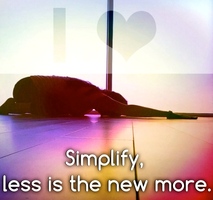This is a great time to be a yoga enthusiast. Flashy clothes, trendy gym bags, celebrity endorsements, and new technology lend itself to a pretty diverse and exciting time in fitness. Now more than ever, people are getting up from their chairs and moving their bodies in ways they never thought were possible unless having previously trained for the Olympics. Our enthusiasm is infectious, our curiosity and trust is a treasure, and clearly our world is a brighter and more interesting place because we "do yoga." However, with all this attention on the HOW of yoga, we have managed to overlook the WHY of yoga. And here is where my story begins...
We are a busy society and have been raised on a steady diet of fast food, coffee, and burning the midnight oil. It's marvelous how we manage to get to yoga class and the gym, meet work deadlines, plan that weekend getaway, drive the kids to soccer practice, Facebook, tweet, or brag about it all, and still have time to create a home-cooked, gourmet, non-GMO, organic, hydroponically-grown, gluten-free dinner for ourselves in the span of about 12 hours. We are pretty amazing creatures. However, keeping up at this pace can be taxing on the autonomic nervous system and lead to fatigue, chronic stress and dis-ease. Whether you know it or not, yoga is one of those activities that supports healthy body responses to some pretty significant stresses in our lives. (2,4) Remember "flight or flight" and "rest and digest" from science class? That's what I am talking about here. This works, but to figure it out, Yoga-tta Be Mind Bendy.
The autonomic nervous system (ANS) is all about stabilizing the body's responses to stress whether from external or internal influences. The ANS is part of the central nervous system, and one of the 12 systems that make up the body. It controls several basic bodily functions including heart rate, body temperature, breathing rate, digestion, and many other systems as well. This is typically outside of our conscious control, and there are plenty of outside stresses that keep out ANS working around the clock: driving in traffic, sleep deficit, work deadlines, generalized anxiety, and demands on our personal schedule. Over time, stress can lead to chronic disease. Not to fret: We can choose to control how we view and recognize stress and pick how we choose to respond to these stresses. Regular yoga practice helps condition the body and the mind to recognize these stresses, conquer them safely and successfully, and get back to homeostasis and business as usual. If this seems logical to you, great! If this is where you struggle, then I'm here to help. (1-3, 5)
Let's get the science outta the way so we can solve this together. "Rest and digest" is the part that belongs to the parasympathetic nervous system (PNS). Its sole function is to execute a long-term survival system by stabilizing the body using rest, relaxation, and rejuvenation. Creating a restive baseline and happy balance within the body helps our other autonomic systems in the body working harmoniously: cardiovascular, respiratory, lymphatic, digestive, circulatory, etc. The less perceived stress the body feels, the better our body can perform its functions that keep us alive; these include regulating our blood pressure, sugar levels, hormone levels, extrapolating nutrients from our food to nourish us, enhancing our reaction time to events, and preventing general daily "wear and tear" on the body. Yoga can help with that. (1-5)
Next, we move to the flight or flight reaction of the sympathetic nervous system (SNS). This is the part of the brain that is stimulated by stress. Sympathetic activation is a change to the body's baseline in response to a perceived threat or incident and will often result in a change to heart rate, blood pressure and hormonal levels. Once a threat is perceived, the SNS works quickly to boost regions of the brain that regulate the response to these threats: perception, fear processing, emotion regulation, defensive reactions, etc. (1-3) This system is your biggest ally in a stressful event and acts as a personal back up buddy. Once the SNS is triggered and acts, a signal is sent back to the PNS, kicking in the "rest and digest" functions by releasing GABA. GABA is one of the many neurotransmitters in our brain whose sole purpose is to calm the body, slow down respiratory and cardiac muscles, increase evaporation to lower body temperature (sweat), etc. (1-3) GABA acts like a referee and helps keep the peace with its "feel good" effects. Our mind is amazing right?
Your Brain on Yoga
Pulling it all together is the vagus nerve. The vagus nerve is a bundle of nerves that originates in the top of the spinal cord. It activates different organs throughout the body such as the heart, lungs, liver and digestive organs when the PNS needs backup calming down the body after a stressful trigger. When active, the vagus nerve is stimulated and helps produce those warm fuzzy feelings that feels like a free hug. It doesn't stop there. The vagus nerve also helps regenerate your organs and cells by activating stem cells, which over time contribute to thicken our brain tissue that normally shrinks with aging. Sounds great! So how does yoga help with all this? Let's hit the mat to find out.
We begin by taking a yoga class. Let me walk you through a yoga practice for those who have or haven't done this activity before. We begin with a restive moment and an easy stretch to center our thoughts, bring our attention inward, and just concentrate on the breath. This is the part where we tap into the autonomic systems of our body, hear our breathing, change its rhythm, feel our heartbeat, and pay attention to the sensations around us. A few minutes of this, and you don't even hear the person breathing next to you, the fans blowing, the street outside, or anything else. It may sound a little too "new age-y," yet the simple act of sitting quietly allows the stimulation the vagus nerve in the brain, induces that relax response, and stimulates the release and increase of the neurotransmitter GABA to act as a dampening mechanism for all things stressful in our lives. (1-3) Yoga-tta Be Mind Bendy for this to work, and you are already halfway there.
Now, we test how well our body performs under stress and how quickly we can get it back to that happy, balanced place. We stand up and start to move the body more vigorously in our Yoga class to build heat in the muscles. We start to flush and possibly sweat, our blood pressure rises, our breathing becomes more frequent, we begin utilize oxygen as energy, and the heart rate elevates. Our movements in yoga class stimulate the "fight our flight" response into taking action. Now, add that controlled breathing from the beginning. All of this stimulating of the "fight or flight" reaction in our yoga class encourages the "rest and digest" reaction to initiate. This stimulates the vagus nerve, increases perspiration to cools the body down, slows down the heart rate and breathing, and the brain releases GABA to create a relaxing feeling.
Continuing with yoga class, we start to slow things down. We sit, we stretch, and finally we take our resting pose. We allow GABA and the "rest and digest" response to do it's job by bringing the body back to homeostasis, lowering our body temperature, slowing down our heart rate and breathing rate. Our brain is flooded with that "feel good" vibe as we sit quietly, we listen to our slowing breath, and we rest. (1, 5)
You may be tempted to ask, "Why is this so important?" If we do not regularly stimulate the "fight or flight" response in controlled ways using yoga and exercise, we may lose the fast reaction time of the "rest and digest" response to aid the body in relaxation and regulation. Healthy stimulation of the "fight or flight" response activated by yoga also stimulates the release of GABA at a more intense level than if we just sat quietly, which aids us in deeper meditation, stays in our system longer, and continues to serve us after yoga class and in our daily lives. Continue to follow this healthy yoga practice daily, and over time we can control our body's responses to external stresses, engage our Yoga breath, and glide through life with more control. (1-4) Join the "YOUR BODY, YOUR YOGA" revolution. It's all up to you.
Melissa Nordin is a Clinical Exercise Physiologist, Anatomy and Physiology Instructor, Registered Yoga Teacher, Fitness Nutrition Specialist, Prenatal Fitness Specialist, Health and Wellness Director, and Life Coach in Florida. Check out her website for free printable classes, sample exercise programs, workshops, and more at www.yogabreezes.com. Follow along with the Yoga-tta Be Bendy Facebook page. Coming Soon: Yoga School of Motion Yoga Alliance approved 20 hour Anatomy and Physiology Program.
SOURCES:







